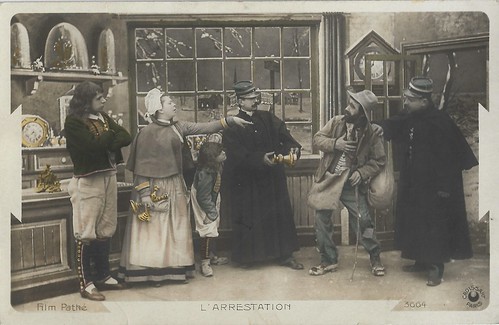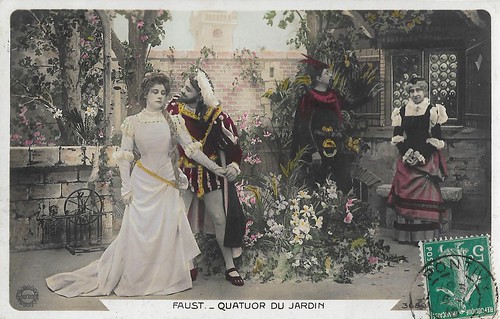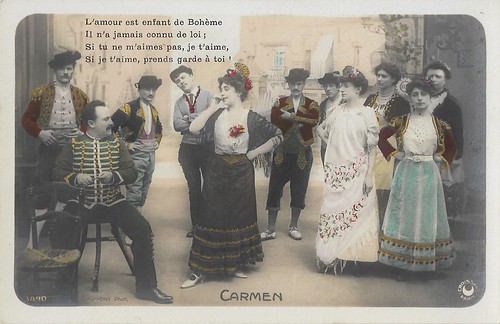The French editor Croissant in Paris published series of coloured postcards for pre-1910 Pathé Frères films. From circa 1905 on, Croissant also published these postcards series for the other major French pioneering studio, Gaumont. These include series for three early sound films, 'Photoscènes', directed by Alice Guy(-Blaché): Faust (1905), Carmen (1906) and Mignon (1906), all three were film adaptations of famous operas.

French postcard by Croissant, Paris. Photo: Film Pathé. Publicity still for Au pays noir/Tragedy in a Coal Mine (Ferdinand Zecca or Lucien Nonguet, 1905). Caption: Dans les galeries [In the mine galleries]. This refers to the 5th scene of the film.

French postcard by Croissant, Paris, no. 3573. Photo: Film Pathé. This is the final scene from La poule aux oeufs d'or (Gaston Velle 1905), adapted from the fable of Jean de la Fontaine. Cinematography and special effects by Segundo de Chomón.

French postcard by Croissant, Paris, no. 3662. Photo: Film Pathé. Publicity still for Le petit poucet/Tom Thumb (1905). Caption: From the top of a tree he saw a small glow.

French postcard by Croissant, Paris, no. 3662. Photo: Film Pathé. Publicity still for Le petit poucet/Tom Thumb (1905). Caption: He put all his family at ease. Le petit poucet/Tom Thumb was an adaptation of Charles Perrault's famous story of 1697. The film by Pathé was worldwide released, in Spanish speaking countries as Pulgarito, in the US as Hop o'my thumb. The director and actors are unknown. The Spanish film scholar Juan-Gabriel Tharrats claimed the Spanish trick film maker Segundo de Chomón (1871-1929), who worked for Pathé in those years, made Le petit poucet. French Wikipedia claims the director was Vincent Lorant-Heilbronn. The Fondation Jerôme Seydoux, keeper of the Pathé heritage, lists no director at all.

French postcard by Croissant, Paris, no. 3664. Photo: Film Pathé. Publicity still for Le chemineau/The Tramp (Albert Capellani, 1905), based on the first part of Victor Hugo's novel 'Les misérables'. Unclear is who the actors are, but sets were by Hugues Laurent. The film appeared in the "Scènes dramatiques et réalistes (8ème Série)" by Pathé.

French postcard by Croissant, Paris, no. 3664. Photo: Film Pathé. Publicity still for Le chemineau/The Tramp (Albert Capellani, 1905), based on the first part of Victor Hugo's novel 'Les misérables'. Arrested at a jeweller, to whom he tries to sell his loot, the gendarmes bring the tramp back to the pastor. Despite all, the pastor wants to exonerate the miserable man's soul and tells a lie to the gendarmes: 'I gave the objects myself to him'. The thief repents.

French postcard by Croissant, Paris, no. 3666. Photo: Film Pathé. Probably publicity still for Peau d'ane/Donkey Skin (Albert Capellani, 1908). Caption: L'infante coiffée d'une peau d'âne (The princess wears a donkey skin). The film was based on a story by Charles Perrault (1697). The actors are unknown.

French postcard by Croissant, Paris, no. 3666. Photo: Film Pathé. Publicity still for Peau d'ane/Donkey Skin (Albert Capellani, 1908). Caption: Le Gateau de Peau d'ane (The Cake of Donkey Skin).

French postcard by Croissant, Paris, no. 3672. Photo: Film Pathé. Publicity still for Un drame à Venise/Venetian Tragedy (Lucien Nonguet, 1906). Sent by mail in 1917. Caption: Au nom de l'honneur. (In the name of Honour). In this early Pathé Frères production, one of the rich palaces of Venice is the setting for a drama of smouldering love and hate. In the Middle Ages, an important lord is not loved by his wife. Despite the sumptuous wealth her husband surrounds her with, the noble dame can only think about a young and handsome Romeo. The lover is surprised by the husband, who kills him and Romeo ends in a canal. The noble lady escapes her death when her husband is stopped by her miraculous beauty... The film is partly in colour.

French postcard by Croissant, Paris, no. 3678. Photo: Film Pathé. Publicity still for Les victimes de l'alcoolisme/Alcohol and Its Victims (Ferdinand Zecca, 1902). Caption: La paresse engendre la misère. (Laziness breeds misery.). Les victimes de l'alcoolisme/Alcohol and Its Victims (1902) is a four minutes short, directed and written by Ferdinand Zecca. It was based on Emile Zola's novel L'Assommoir', and the first Zola adaptation ever. Les victimes de l'alcoolisme/Alcohol and Its Victims tells a moral story on what happens to a man if he starts to drink and gamble. Bob Lipton at IMDb: "this is a very advanced film for 1902, being offered in five scenes, on elaborately painted sets. It was probably not intended solely for movie programs, but for anti-booze lectures, Chautauquas, and conferences."

French postcard by Croissant, Paris, no. 3680. Photo: Gaumont. Publicity still for the phonoscène Faust (Alice Guy, ca. 1905). The earliest proof of a showing of the film dates from 1905, so the film dates from that year or just before. The captions refer to lines from the opera libretto by Jules Barbier and Michel Carré for the opera 'Faust' (1859) by Charles Gounod. This card refers to no. 4, the Duet between Faust and Mephistopheles in the First Act.

French postcard by Croissant, Paris, no. 3680. Photo: Gaumont. Publicity still for the phonoscène Faust (Alice Guy, ca. 1905). This card refers to the Quartet between Faust, Marguerite, Mephistopheles, and Marthe, no. 16 of the Third Act.

French postcard by Croissant, Paris, no. 3871. Photo: Gaumont. Publicity still for Mignon (Alice Guy, 1906). Caption: Est-ce bien Mignon que voilà? (How cute is that?)

French postcard by Croissant, Paris, no. 3871. Photo: Gaumont. Publicity still for Mignon (Alice Guy, 1906). Caption: Adieu Mignon, courage! Ne pleure pas! (Adieu Mignon, courage! Do not Cry!) Alice Guy directed nine (or seven - the sources differ) scenes from the opera 'Mignon' for a synchronised sound film, in the Gaumont Chronophone Studio, Paris, in 1906. 'Mignon' (1966) is an opéra comique in three acts by Ambroise Thomas. The original French libretto was by Jules Barbier and Michel Carré, based on Goethe's novel 'Wilhelm Meisters Lehrjahre'.

French postcard by Croissant, Paris, no. 3890. Photo: Gaumont. Publicity still for the phonoscène Carmen (Alice Guy, 1906). The film consisted of 12 so-called phonoscènes, an early sound-on-disc system. The film is presumed lost. Unknown is who the singers are. Carmen flirts with the toreador before his fight with the bull: "Toréador, en garde, et songe en combattant. Qu'un oeil noir te regarde et que l'amour t'attend." (Toreador, on guard, and dream of fighting. Let a black eye look at you and let love await you.)

French postcard by Croissant, Paris, no. 3890. Photo: Gaumont. Publicity still for the phonoscène Carmen (Alice Guy, 1906). The gypsy girl Carmen challenges Don José: "L'amour est enfant de Bohème, Il n'a jamais connu de loi; Si tu ne m'aimes pas, je t'aime, Si je t'aime, Prends garde à toi." (Love is Bohemian's child, He never knew any law; If you don't love me, I love you, If I love you, be careful!) Mark the half visible logo Elge behind the most right woman; it it stands for L.G., the initials of Gaumont owner and founder Léon Gaumont.

French postcard by Croissant, Paris, no. 1530/8. Photo P. Boyer. Sarah Bernhardt in La dame aux camélias (André Calmettes, Louis Mercanton, 1912). The film was produced by Le Film d'Art and distributed by Pathé Freres. Caption: Sleep in peace, Marguerite! Much will be pardoned to you, because you have loved so much!
Sources: Fondation Jerome Seydoux (French), Roberta and Simone Blaché (The Memoirs of Alice Guy Blaché), Alison McMahan (Alice Guy Blaché: Lost Visionary of the Cinema), Alison McMahan (Women Film Pioneers Project), Bob Lipton (IMDb), Kinomata: la donna nel cinema, Wikipedia (English and French) and IMDb.

French postcard by Croissant, Paris. Photo: Film Pathé. Publicity still for Au pays noir/Tragedy in a Coal Mine (Ferdinand Zecca or Lucien Nonguet, 1905). Caption: Dans les galeries [In the mine galleries]. This refers to the 5th scene of the film.

French postcard by Croissant, Paris, no. 3573. Photo: Film Pathé. This is the final scene from La poule aux oeufs d'or (Gaston Velle 1905), adapted from the fable of Jean de la Fontaine. Cinematography and special effects by Segundo de Chomón.

French postcard by Croissant, Paris, no. 3662. Photo: Film Pathé. Publicity still for Le petit poucet/Tom Thumb (1905). Caption: From the top of a tree he saw a small glow.

French postcard by Croissant, Paris, no. 3662. Photo: Film Pathé. Publicity still for Le petit poucet/Tom Thumb (1905). Caption: He put all his family at ease. Le petit poucet/Tom Thumb was an adaptation of Charles Perrault's famous story of 1697. The film by Pathé was worldwide released, in Spanish speaking countries as Pulgarito, in the US as Hop o'my thumb. The director and actors are unknown. The Spanish film scholar Juan-Gabriel Tharrats claimed the Spanish trick film maker Segundo de Chomón (1871-1929), who worked for Pathé in those years, made Le petit poucet. French Wikipedia claims the director was Vincent Lorant-Heilbronn. The Fondation Jerôme Seydoux, keeper of the Pathé heritage, lists no director at all.

French postcard by Croissant, Paris, no. 3664. Photo: Film Pathé. Publicity still for Le chemineau/The Tramp (Albert Capellani, 1905), based on the first part of Victor Hugo's novel 'Les misérables'. Unclear is who the actors are, but sets were by Hugues Laurent. The film appeared in the "Scènes dramatiques et réalistes (8ème Série)" by Pathé.

French postcard by Croissant, Paris, no. 3664. Photo: Film Pathé. Publicity still for Le chemineau/The Tramp (Albert Capellani, 1905), based on the first part of Victor Hugo's novel 'Les misérables'. Arrested at a jeweller, to whom he tries to sell his loot, the gendarmes bring the tramp back to the pastor. Despite all, the pastor wants to exonerate the miserable man's soul and tells a lie to the gendarmes: 'I gave the objects myself to him'. The thief repents.

French postcard by Croissant, Paris, no. 3666. Photo: Film Pathé. Probably publicity still for Peau d'ane/Donkey Skin (Albert Capellani, 1908). Caption: L'infante coiffée d'une peau d'âne (The princess wears a donkey skin). The film was based on a story by Charles Perrault (1697). The actors are unknown.

French postcard by Croissant, Paris, no. 3666. Photo: Film Pathé. Publicity still for Peau d'ane/Donkey Skin (Albert Capellani, 1908). Caption: Le Gateau de Peau d'ane (The Cake of Donkey Skin).

French postcard by Croissant, Paris, no. 3672. Photo: Film Pathé. Publicity still for Un drame à Venise/Venetian Tragedy (Lucien Nonguet, 1906). Sent by mail in 1917. Caption: Au nom de l'honneur. (In the name of Honour). In this early Pathé Frères production, one of the rich palaces of Venice is the setting for a drama of smouldering love and hate. In the Middle Ages, an important lord is not loved by his wife. Despite the sumptuous wealth her husband surrounds her with, the noble dame can only think about a young and handsome Romeo. The lover is surprised by the husband, who kills him and Romeo ends in a canal. The noble lady escapes her death when her husband is stopped by her miraculous beauty... The film is partly in colour.

French postcard by Croissant, Paris, no. 3678. Photo: Film Pathé. Publicity still for Les victimes de l'alcoolisme/Alcohol and Its Victims (Ferdinand Zecca, 1902). Caption: La paresse engendre la misère. (Laziness breeds misery.). Les victimes de l'alcoolisme/Alcohol and Its Victims (1902) is a four minutes short, directed and written by Ferdinand Zecca. It was based on Emile Zola's novel L'Assommoir', and the first Zola adaptation ever. Les victimes de l'alcoolisme/Alcohol and Its Victims tells a moral story on what happens to a man if he starts to drink and gamble. Bob Lipton at IMDb: "this is a very advanced film for 1902, being offered in five scenes, on elaborately painted sets. It was probably not intended solely for movie programs, but for anti-booze lectures, Chautauquas, and conferences."

French postcard by Croissant, Paris, no. 3680. Photo: Gaumont. Publicity still for the phonoscène Faust (Alice Guy, ca. 1905). The earliest proof of a showing of the film dates from 1905, so the film dates from that year or just before. The captions refer to lines from the opera libretto by Jules Barbier and Michel Carré for the opera 'Faust' (1859) by Charles Gounod. This card refers to no. 4, the Duet between Faust and Mephistopheles in the First Act.

French postcard by Croissant, Paris, no. 3680. Photo: Gaumont. Publicity still for the phonoscène Faust (Alice Guy, ca. 1905). This card refers to the Quartet between Faust, Marguerite, Mephistopheles, and Marthe, no. 16 of the Third Act.

French postcard by Croissant, Paris, no. 3871. Photo: Gaumont. Publicity still for Mignon (Alice Guy, 1906). Caption: Est-ce bien Mignon que voilà? (How cute is that?)

French postcard by Croissant, Paris, no. 3871. Photo: Gaumont. Publicity still for Mignon (Alice Guy, 1906). Caption: Adieu Mignon, courage! Ne pleure pas! (Adieu Mignon, courage! Do not Cry!) Alice Guy directed nine (or seven - the sources differ) scenes from the opera 'Mignon' for a synchronised sound film, in the Gaumont Chronophone Studio, Paris, in 1906. 'Mignon' (1966) is an opéra comique in three acts by Ambroise Thomas. The original French libretto was by Jules Barbier and Michel Carré, based on Goethe's novel 'Wilhelm Meisters Lehrjahre'.

French postcard by Croissant, Paris, no. 3890. Photo: Gaumont. Publicity still for the phonoscène Carmen (Alice Guy, 1906). The film consisted of 12 so-called phonoscènes, an early sound-on-disc system. The film is presumed lost. Unknown is who the singers are. Carmen flirts with the toreador before his fight with the bull: "Toréador, en garde, et songe en combattant. Qu'un oeil noir te regarde et que l'amour t'attend." (Toreador, on guard, and dream of fighting. Let a black eye look at you and let love await you.)

French postcard by Croissant, Paris, no. 3890. Photo: Gaumont. Publicity still for the phonoscène Carmen (Alice Guy, 1906). The gypsy girl Carmen challenges Don José: "L'amour est enfant de Bohème, Il n'a jamais connu de loi; Si tu ne m'aimes pas, je t'aime, Si je t'aime, Prends garde à toi." (Love is Bohemian's child, He never knew any law; If you don't love me, I love you, If I love you, be careful!) Mark the half visible logo Elge behind the most right woman; it it stands for L.G., the initials of Gaumont owner and founder Léon Gaumont.

French postcard by Croissant, Paris, no. 1530/8. Photo P. Boyer. Sarah Bernhardt in La dame aux camélias (André Calmettes, Louis Mercanton, 1912). The film was produced by Le Film d'Art and distributed by Pathé Freres. Caption: Sleep in peace, Marguerite! Much will be pardoned to you, because you have loved so much!
Sources: Fondation Jerome Seydoux (French), Roberta and Simone Blaché (The Memoirs of Alice Guy Blaché), Alison McMahan (Alice Guy Blaché: Lost Visionary of the Cinema), Alison McMahan (Women Film Pioneers Project), Bob Lipton (IMDb), Kinomata: la donna nel cinema, Wikipedia (English and French) and IMDb.
No comments:
Post a Comment